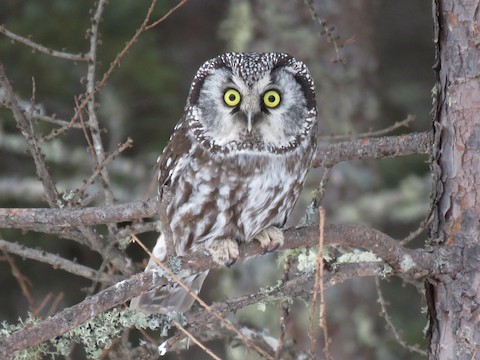Birdfinding.info ⇒ Uncommon and generally difficult to find over most of its large range. In the U.S., fairly consistent, accessible sites include: Cameron Pass, Colorado (along State Route 14 west of Fort Collins); Grand Mesa, Colorado; Yale-Kilgore Road, Idaho (just west of Yellowstone National Park); Sax-Zim Bog, Minnesota; and Fairbanks, Alaska. In Canada: Sibbald Creek Trail (west of Calgary, Alberta); and Hecla-Grindstone Provincial Park (north of Winnipeg, Manitoba). In Europe: Plan, in the Spanish Pyrenees; Park Narodowy Gor Stolowych, in western Poland; Styggkarrets and Fabodmossens Nature Reserves, northwest of Uppsala, Sweden; and Oulu in northern Finland.
Boreal Owl
Strix nebulosa
Taiga and montane coniferous forests of Eurasia and North America. Eurasian and North American populations are sometimes recognized as distinct forms: “Tengmalm’s Owl” (funereus plus five other subspecies) of Eurasia; and “Richardson’s Owl” (richardsoni) of North America.

Approximate distribution of the Boreal Owl. © Xeno-Canto 2023
In Eurasia, “Tengmalm’s Owl” is resident essentially throughout the taiga belt from Scandinavia east to Chukotka, the Kamchatka Peninsula, and Sakhalin. Also occurs southward in coniferous forests of continental Europe (south to the Pyrenees, the Alps, and northern Greece) and central Asia (from Tajikistan to northern Xinjiang).
More isolated, little-reported populations inhabit mountains of northwestern Turkey, the Caucasus region (Georgia, Armenia, and northeastern Turkey), north-central Iran, the western Himalayas (e.g., two specimens collected in Himachal Pradesh in 1936 and multiple photographs from Gilgit-Baltistan in 2022), central China (Gansu), and Hokkaido.
In North America, “Richardson’s Owl” is resident from central Alaska east through forested regions of Canada to Newfoundland, and locally south in several mountain ranges into the western U.S., including the Cascades (to southwestern Oregon), the Blue Mountains, the Wasatch, and the Rockies (to northern New Mexico).
All populations appear to be mostly sedentary overall, with some regular dispersal in fall and winter. Localized irruptions have occurred in some winters, resulting in numerous records south of the usual range in the Great Lakes region, New England, and the Maritime Provinces, and west of the usual range in continental Europe.
Exceptional vagrants have been recorded as far afield as Nebraska, Iowa, New York City, Long Island, Nantucket, the Shetlands, Scotland, St. Lawrence Island, and the Pribilofs.
Identification
A small, plump owl with a proportionately large head and a strongly defined facial disk. Mostly nocturnal and rarely seen.
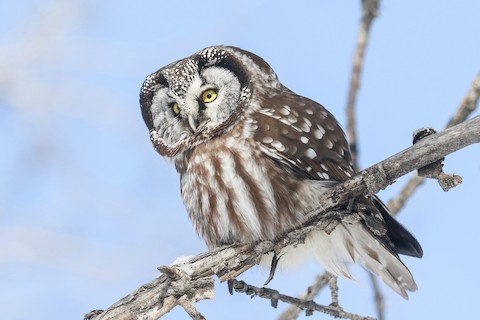
“Richardson’s Owl”, A. f. richardsoni, showing well-defined, black-framed facial disk. (Weaselhead Natural Area, Calgary, Alberta; February 27, 2021.) © Ethan Denton
The facial disk has mostly whitish feathering around the eyes, framed by a thick, mostly blackish border—with patches of dense white spots across the top and in the bottom corners. In the center of the face, between the eyes and above the bill, is a fringe of bushy whitish feathers in the shape of a Y.
The eyes are bright-yellow and the bill typically appears either yellowish or grayish. Viewed frontally, with the eyes wide-open, its features can convey an expression of surprise or astonishment.
The upperparts are mostly dark-brown with variable white spotting on the wings and back. The crown has a high density of small white spots.
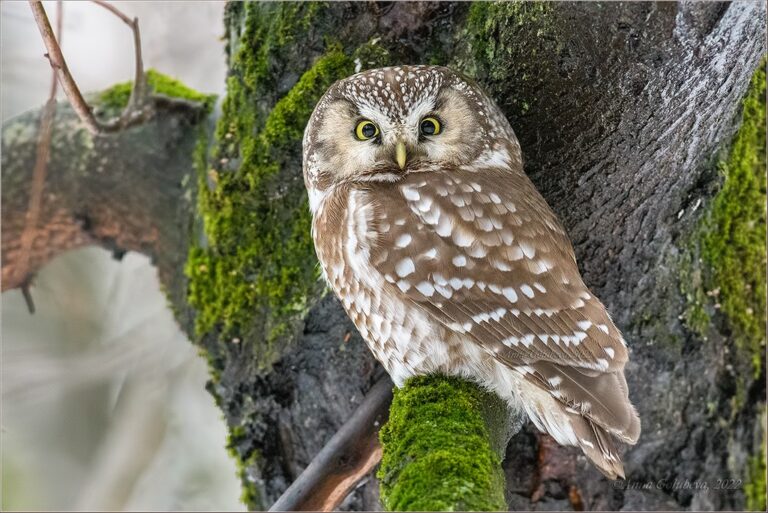
“Tengmalm’s Owl”, A. f. funereus. (Moscow, Russia; January 14, 2022.) © Anna Solisia
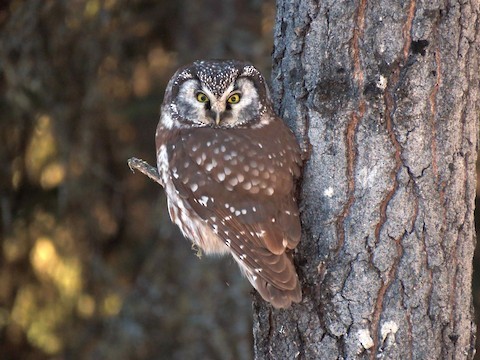
“Richardson’s Owl”, A. f. richardsoni. (Fairbanks, Alaska; March 21, 2021.) © Gerald Frost
The underparts are white with brown streaks or spots, or a blend of streaking and spotting. Eurasian populations typically have spotted underparts, whereas North American populations tend to show distinct streaks—but all populations appear to vary somewhat in the pattern on the underparts

“Tengmalm’s Owl”, A. f. funereus. (Chkalovskiy, Nizhegorod, Russia; February 10, 2017.) © g_kolotin

“Richardson’s Owl”, A. f. richardsoni. (Cottonwood Lake, Wasilla, Alaska; October 22, 2022.) © Timothy Piranian
The juvenile is unmarked dark-brown overall, with a somewhat paler shade of brown on the underparts and whitish markings around the eyes.

“Tengmalm’s Owl”, A. f. funereus, juvenile. (Horná Orava, Žilinský Kraj, Slovakia; May 20, 2008.) © Stanislav Harvančík
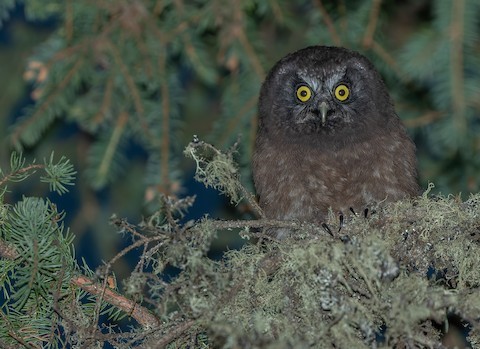
“Richardson’s Owl”, A. f. richardsoni, juvenile. (Yukon Flats, Alaska; July 9, 2022.) © Joachim Bertrands
Notes
Polytypic species consisting of seven recognized subspecies that potentially comprise two distinct forms: “Tengmalm’s Owl” (funereus plus five subspecies) of Eurasia; and “Richardson’s Owl” (richardsoni) of North America.
The British refer to the species as a whole as Tengmalm’s Owl. Although this name may be regarded as having historical priority, the use of “Boreal” to refer to the collective enables the parallel naming of the two potentially distinct forms as “Tengmalm’s” and “Richardson’s” (and I am writing in North America, where “Tengmalm’s” sounds wrong to most of us).
See below for a comparison of the Boreal Owl with the Northern Saw-whet Owl.
Cf. Northern Saw-whet Owl. Boreal and Northern Saw-whet Owls can occur together over large portions of North America, from south-coastal Alaska south to Oregon and New Mexico and east to southern Quebec. Boreal is somewhat larger and longer-tailed, and has proportionately smaller-looking eyes—a difference that is often noticeable without a direct, side-by-side comparison.
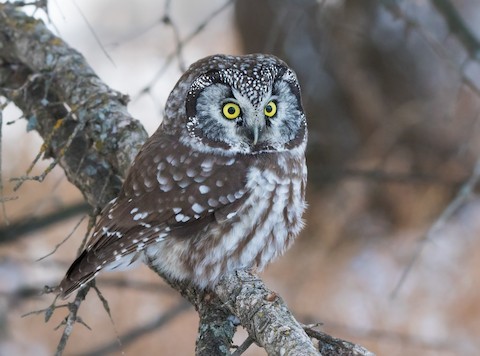
“Richardson’s Owl”, A. f. richardsoni. (Rosetown, Saskatchewan; December 18, 2021.) © Nick Saunders

Northern Saw-whet Owl, showing typical pattern and coloration—bold rusty-brown streaks on the underparts and a distinct white streak on the back. (Braddock Bay, New York; February 28, 2009.) © Chris Wood
Differences in coloration and pattern are diagnostic on most well-seen individuals:
Overall Coloration: Boreal is typically clad in dark, cold shades of brown; whereas most Northern Saw-whets appear rusty medium-brown—especially on the underparts.
Facial Disk Contrast: Boreal’s facial disk is framed by a bold, mostly blackish outer fringe that contrasts noticeably with the whitish interior; whereas Northern Saw-whet’s facial disk usually shows a weakly defined brown outer fringe (though some individuals resemble Boreal in this respect).
Underparts Pattern: Boreal’s underparts pattern varies from streaked to spotted, with many individuals showing a blend of streaks and spots; whereas Northern Saw-whet typically shows distinct, bold brownish streaks that are cleanly separated by white.
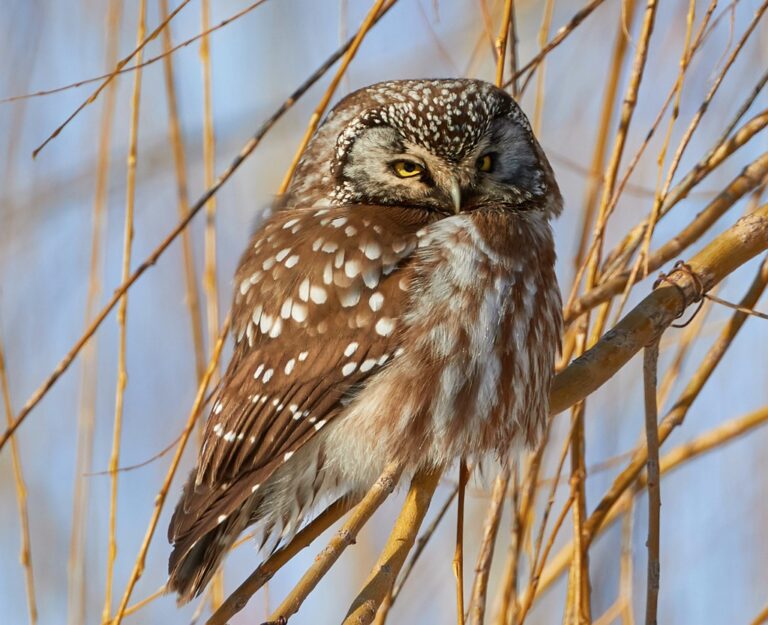
“Richardson’s Owl”, A. f. richardsoni, with atypical rusty-brown coloration, resembling that of the Northern Saw-whet Owl. (De la Fayère Park, Boucherville, Quebec; January 31, 2021.) © David Bird
Upperparts Pattern: Boreal’s upperparts are brown with variable white spotting over most of the back and wings; whereas Northern Saw-whet’s upperparts are mostly pure-brown with a few white spots and streaks that are concentrated on the sides of the back (often forming distinct “braces”).
Bill Color: Boreal’s bill usually appears either yellowish or grayish or horn-colored; whereas Northern Saw-whet’s bill usually appears jet-black.
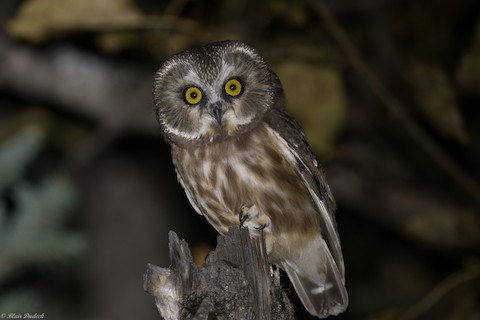
Northern Saw-whet Owl, showing atypical pattern and coloration—indistinct cold-brown streaks on the underparts—but note the black bill and pale-framed facial disk. (Mugaha Marsh, Mackenzie, British Columbia; September 17, 2019.) © Blair Dudeck
More Images of the Boreal Owl

“Tengmalm’s Owl”, A. f. funereus—or possibly caucasicus. (Northern Türkiye.) © Emin Yogurtcuoglu
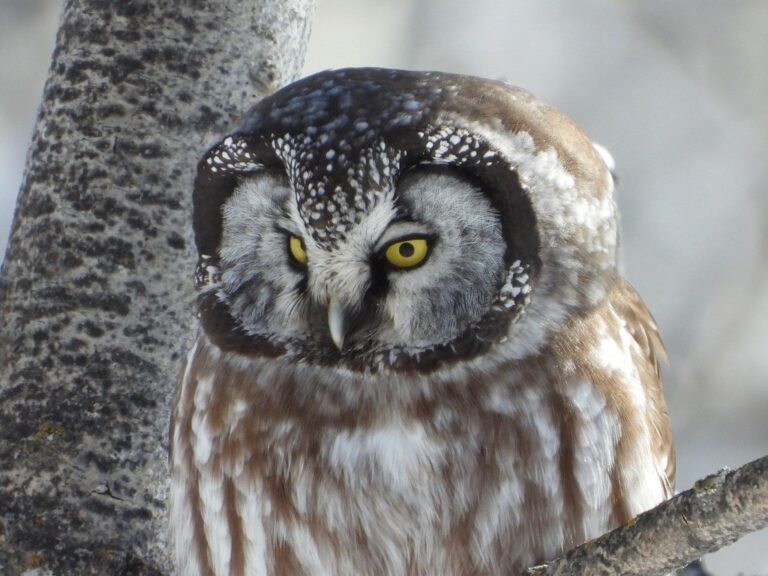
“Richardson’s Owl”, A. f. richardsoni. (Calgary, Alberta; February 2021.) © Evan Walters
References
Alderfer, J., and J.L. Dunn. 2021. National Geographic Complete Birds of North America (Third Edition). National Geographic Society, Washington, D.C.
BirdLife International. 2021. Aegolius funereus. The IUCN Red List of Threatened Species 2021: e.T22689362A201898946. https://dx.doi.org/10.2305/IUCN.UK.2021-3.RLTS.T22689362A201898946.en. (Accessed January 14, 2023.)
Brazil, M. 2009. Birds of East Asia. Princeton University Press.
eBird. 2022. eBird: An online database of bird distribution and abundance. Cornell Lab of Ornithology, Ithaca, N.Y. http://www.ebird.org. (Accessed January 14, 2023.)
iNaturalist. 2023. https://www.inaturalist.org/. (Accessed January 14, 2023.)
König, C., and F. Weick. 2008. Owls of the World (Second Edition). Yale University Press.
Mikkola, H. 2012. Owls of the World: A Photographic Guide. Firefly Books, London.
Mullarney, K., L. Svensson, D. Zetterström, and P.J. Grant. 1999. Birds of Europe. Princeton University Press.
Salt, W.R., and J.R. Salt. 1976. The Birds of Alberta. Hurtig Publishers, Edmonton, Alberta.
Sibley, D.A. 2014. The Sibley Guide to Birds (Second Edition). Alfred A. Knopf. New York.
Xeno-Canto. 2023. Boreal Owl – Aegolius funereus. https://xeno-canto.org/species/Aegolius-funereus. (Accessed January 14, 2023.)
